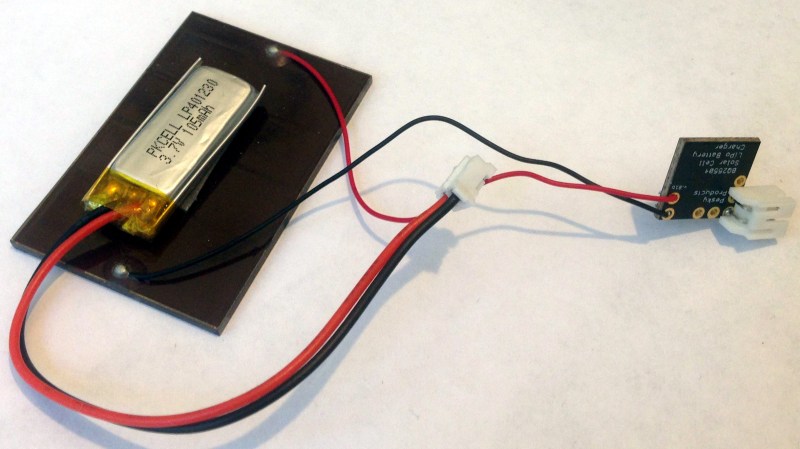This half-inch square ultra-low power energy harvesting LiPo cell charger by [Kris Winer] uses a low voltage solar panel to top up a small lithium-polymer cell, which together can be used as the sole power source for projects. It’s handy enough that [Kris] uses them for his own projects and offers them for sale to fellow hackers. It’s also his entry into the Power Harvesting Challenge of the Hackaday Prize.
The board is essentially a breakout board for the Texas Instrument BQ25504, configured to charge and maintain a single lithium-polymer cell. The BQ25504 is an integrated part that takes care of most of the heavy lifting and has nifty features like battery health monitoring and undervoltage protection. [Kris] has been using the board along with a small 2.2 Volt solar panel and a 150 mAh LiPo cell to power another project of his: the SensorTile environmental data logger.
It’s a practical and useful way to test things; he says that an average of 6 hours of direct sunlight daily is just enough to keep the 1.8 mA SensorTile running indefinitely. These are small amounts of power, to be sure, but it’s free and self-sustaining which is just what a remote sensing unit needs.



















Welp. This is what I was doing, but with supercaps.
Self-sustaining I can understand although, what happens if you have a couple of cloudy days in a row? But free?
The chip has a “power ok” pin that signals that the battery has enough charge to operate. Presumably if you were worried about it you would use this to have the device recover once the battery had built up enough charge.
To address the “couple of cloudy days in a row” problem you could just add a larger battery. Say, as large as the solar cell array, instead of the tiny one shown.
You could even charge it up beforehand, as insurance, and it could last weeks before needing a solar charge.
If you’re stingy, you could even use plain old alkaline batteries: a couple of bucks worth will give you well over a year of backup time.
I tried reading the .io page to understand the power usage more, but [kris] lost me at “7 mA per hour”.
I love the build, but as far as cost goes it’s a little steep. I’ve just hacked a boost converter into a Walmart solar light for my outdoor sensors. I get everything for around $10 USD then just add the micro controller/sensors. Even the little $1 lights put out ~25mA short circuit and have an open circuit voltage of 2.4 VDC.
I once looked at a very cheap supermarket solar lights too, ones that use a 2/3 AAA battery. The problem was that the step up circuit was very inefficient, even without the LED it would burn too much power so there was no guarantee the battery would last long enough.
I think the simplest way is to just strap 3 in series together and add an LDO to 3.3V for your projects.
I considered this project, but realised I could just use a higher voltage solar panel. Get one the same size. You’ll have more, smaller cells. Lower current, but the same wattage in the end and a more directly useful voltage.
Very nice. This is similar to my Tiny Solar Energy Module. https://hackaday.io/project/159139-tiny-solar-energy-module-tsem
That has on-board solar cells and 3.3V output. It is still possible to use external solar panel.
From .io the page: “can get 7 mAH of power per hour of sun” – which I take to be that he’s getting an effective battery charge of 7 mAH, although the Vin from from the solar cell is less (and therefore actually a higher current). The page also details having used an alkaline (though in a boost configuration) which ran for just 18 days.
I have several BQ25570 nanopower converters – very similar to the device used in this design, but slightly newer generation. Basically, operational range is slightly increased over the part used here, but otherwise very similar. That has programmable voltage cutoffs – I wonder if something similar is what is tripping up Kris?
I’m not running the sensor stuff Kris is, but I have several ATTiny43U devices (AVR architecture with a built-in boost controller) running off of single AA Alkaline cells (started with partially depleted cell at 1320mV, and after six months has dropped only 12mV in use), so I must expect the 18 day runtime was with something running at a higher load than expected.
Using processor sleep and a GPIO to switch power for connected devices would be an effective way to drop to minimal power consumption – if you’re waking, taking readings and beaconing them, no need to keep everything running constantly (though sensor ‘warm up” and such could be an issue for some devices).
I realize size can be a constraint, but a bog-standard 18650 cell is cheap and has an enormous capacity for its size. If you’re conservative with your power consumption, a low current device would be able to run quite a while without getting much of a boost from solar.
“From .io the page: “can get 7 mAH of power per hour of sun” – which I take to be that he’s getting an effective battery charge of 7 mAH, ”
No, [Kris] actually wrote “generating an average of ~7 mA per hour “, which is nonsensical.
It’s reasonable to infer he is generating an average charge rate of 7 mA (or 7 mAh per hour if you prefer to obfuscate it) over the stated charging period of 6 hours, yielding 42 mAh, not 7 mAh. This is also consistent with him saying 6 hours of charge will power the 1.8 mA load for a day.
It implies he’s getting somewhere north of 40 mW peak out of that solar cell, which is about right for the size of solar panel and poor lighting conditions (20 klux) he mentions.